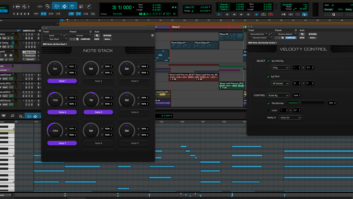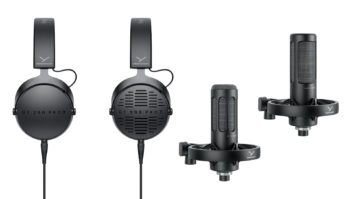The number of mind-blowing, incredibly useful plug-ins flooding the market continues to amaze me. It seems there are plug-ins for almost every task, from basic dynamics to outlandish effects and invaluable editing tools. Although it’s hard to pick a favorite, I particularly appreciate software that helps automate mundane, laborious editing tasks. Digidesign’s new AudioSuite plug-in, SoundReplacer, is just such a plug-in.
As its name implies, this software can take just about any sound and replace it with another. Pretty straightforward, nothing that exciting here, right? But SoundReplacer is deeper than its name implies. For this “Field Test,” Version 1.1 was put through the paces on a 24 MIXplus system running Pro Tools 5.0.
Installation of SoundReplacer is completely routine-you simply run the installer program on the CD. The plug-in is plunked into your DAE folder’s Plug-Ins folder, and a Presets folder is put into the Plug-In Settings folder. The Settings folder is a bit larger than most (324K), as it contains actual audio files, the samples that go along with its demo presets.
The tutorial session, which takes up about 15 MB of disk space, is also dropped into your hard drive. It’s nothing to write home about, but it’s helpful if you have no idea what the program is good for-probably not the case if you actually went out and bought it. However, this plug-in is a breeze to navigate, and most folks will be able to get right to work on it with hardly a glance at the manual. If you need the SoundReplacer manual, however, it is one of several in the Digidesign Plug-In User’s Guide; a copy of the booklet comes with the program. It’s well-written and has some solid user tips. I recommend flipping through it.
Copy protection is via key disk, as usual. You get one install, so don’t lose it.
Happy TriggersAs many as three samples can be loaded into SoundReplacer simultaneously. Each sample can be set to trigger at a different threshold.
Dedicated sliders, one per sample, allow easy adjustment of the thresholds. The threshold zones are visible in scales of gray, from light (most sensitive) to dark (least sensitive). Individual trigger points are delineated by different colored horizontal lines: yellow for sample 1, red for sample 2, and blue for sample 3. The colors and controls combine to make a user interface that’s a breeze to work with.
A dynamics slider controls how new samples trace the original track’s velocities. Settings range from 0.25:1 (11/44 the original velocities) to 4:1 (four times more dynamic than the original velocities). A 1:1 ratio is the plug-in’s default setting. The dynamics control is global, affecting all three sample zones. (Discrete control over each zone, via individual sliders, would be particularly cool-maybe in the future.) The ability to tweak the velocities of your replacement samples is invaluable for music production. For example, replacing a live snare with a 909-type snare, but without the velocities of the live track, will produce a more electronic, drum machine-like, sound.
The mix ratio between the original track and the replacement samples is fully adjustable from zero to 100%. The mix function, like the dynamics function, is global, affecting the wet/dry ratio of all the samples. (Discrete mix control of each sample would be a nice feature to include.) The ability to blend the original track’s sound with the replacement samples is a nice option, opening the door to some great creative sound mangling possibilities.
SoundReplacer can drop phase-coherent samples. That is, the program will actually align the peaks of the replacement samples to match the peaks of the waveforms in the original track-don’t try this with conventional MIDI triggering! No time compression or expansion is used; it’s simply a matter of how the program places the samples. Of course, this effect can be detrimental to timing, especially with music or really tight cues. Because SoundReplacer is concentrating on phase coherency over a sample-accurate start time, waveforms with radically different attacks may not line up properly. If, say, you want to replace a percussive clave sound with a whooshing vocal “aah” sound, you should disable Peak Align so that only the sample start times are aligned (the default setting is Peak Align On).
Samples from different threshold zones can be automatically crossfaded. With this function on (another default that’s on when you open the plug-in), the samples are seamlessly blended together, even if one sample’s attack triggers before the end of another’s decay. You can turn crossfading off if you prefer having everything hard-cut. However, I found crossfading generally gave the smoothest results. It was active most of the time when I used the plug-in because it created very natural-sounding percussion tracks as samples with different velocities were crossfaded back and forth. The crossfade time, unfortunately, is not adjustable.
Time and ReplaceTo load a sound into the plug-in, you use a button labeled Update. There’s no import track button, which, at first glance, is the only really confusing thing about the interface. Select a region in Pro Tools’ Edit window, hit Update, and the audio is sent to SoundReplacer. An associated button, Auto Update, makes this entire procedure automatic. Turn Auto Update on (its default setting is off), and every time you select a region, SoundReplacer automatically imports it. I’m not sure what the point of this is, but I guess it could come in handy for something.
Loading samples is a simple matter of clicking on a floppy disk icon beneath the threshold sliders. (There’s one icon per slider for each of the three samples.) After clicking an icon, a Load File window appears through which you can search your hard drive for suitable samples. SoundReplacer reads SDII and .WAV file formats. The addition of .AIFF would be most appreciated; I have a lot of samples in this format, and I’m sure other folks do, too. However, there’s no way to audition samples from the Load File window, which is a disappointment. This is a big inconvenience, because you often need to audition a bunch of samples in order to find just the right one. Note to Digidesign: Add a way to listen to files before loading them, please.
Because samples are an essential part of SoundReplacer’s presets, which contain threshold levels, mix, dynamics, associated samples, etc., the program has its own Audio Files folder inside its Plug-In Settings folder for storing samples. This is very convenient, as it helps keep the presets’ sound bites from getting misplaced. If, for example, you like to augment your kick tracks with a particular 808 kick sample, keep that sample in the Audio Files folder for quick access. At install, the sample storage folder is 324K (the program comes with a few samples as part of its demo) but has the potential to grow to enormous size. In order to avoid filling up your system drive, you may want to keep only your most often used samples in the folder.
The final processed track is a contiguous file of all three samples, along with the dynamics, mix and other parameter settings. It can be written to any track in your session. No need to write over the original audio, just open up another track and drop the new file there. This also gives you the added option of mixing the processed track with the original track to taste, in real time.
Replacer-ManOne of my favorite production tricks is to beef up weak recordings by layering them with samples, but I find that traditional MIDI triggering methods produce awful timing. My solution, which is to place each replacement sample manually for spot-on timing, is way too tedious, although it does yield excellent results. My kicks are always phat, and my snares totally snap. I’m almost embarrassed to admit that SoundReplacer does in the blink of an eye what used to take me hours-what a time-saver!
But there’s no reason that SoundReplacer should be limited just to music production applications. You could get seriously creative with this plug-in and cook up some killer sound effects by layering samples endlessly atop each other. And, since replacement samples can be dropped back into your session at exactly the same spot as the original waveform, it’s perfect for replacing your tired old cues with one of your new humongous ones. Be still my beating heart. At $395, it’s not a bad deal either-definitely a worthy plug-in to keep in your audio production toolbox.
Digidesign Inc., 3401-A Hillview Ave., Palo Alto, CA 94304; 650/842-7900; fax 650/842-7999; www.digidesign.com.







